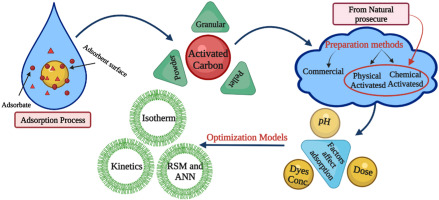Breadcrumb
Comparative Studies of Using Nano Zerovalent Iron, Activated Carbon, and Green Synthesized Nano Zerovalent Iron for Textile Wastewater Color Removal Using Artificial Intelligence, Regression Analysis, Adsorption Isotherm, and Kinetic Studies
Daily, a big extent of colored, partially treated textile effluents drained into the sanitation systems causing serious environmental concerns. Therefore, the decolorization treatment process of wastewater is crucial to improve effluent quality. In the present study, 3 different sorbent materials, nano zerovalent iron (nZVI), activated carbon (AC), and green-synthesized nano zerovalent iron (GT-nZVI), have been prepared for raw textile wastewater decolourization. The prepared nanomaterials were characterized via X-ray diffraction (XRD) spectroscopy, scanning electron microscopy (SEM), energy dispersive X-ray (EDX) analysis, and UV-Vis absorption spectroscopy. In addition, the effect of different operating parameters such as pH, contact time, and stirring rate on the color removal efficiency was extensively studied to identify the optimum removal conditions. The reaction temperature, adsorbent dose, and initial color concentration were fixed during the experiments at room temperature, 0.7 g/L, and 350 and 50 mg/L Pt/Co color unit, respectively. Moreover, adsorption and reaction kinetics were analyzed using different isotherms and models. For simulating the adsorption process, artificial neural network (ANN) data were compatible with the result of regression analysis derived from response surface methodology (RSM) optimization. Our results showed the higher ability of nZVI, AC, and GT-nZVI in textile wastewater color removal. At pH 5, contact time 50 minutes, and stirring rate 150 rpm, nZVI showed good color removal efficiency of about 71% and 99% for initial color concentrations of 350 and 50 mg/L Pt/Co color unit, respectively. While slightly higher color removal ability of about 72% and 100% was achieved by using AC at pH 8, contact time 70 minutes, and stirring rate 250 rpm. Finally, the largest ability of color removal about 85% and 100% was recorded for GT-nZVI at pH 7, contact time 40 minutes, and stirring rate 150 rpm. This work shows the enhanced color removal ability of GT-nZVI as a potential textile wastewater decolourization material, opening the way for many industrial and environmental applications. © The Author(s) 2020.



